Seakeeper 1: installed, on the water, and stable
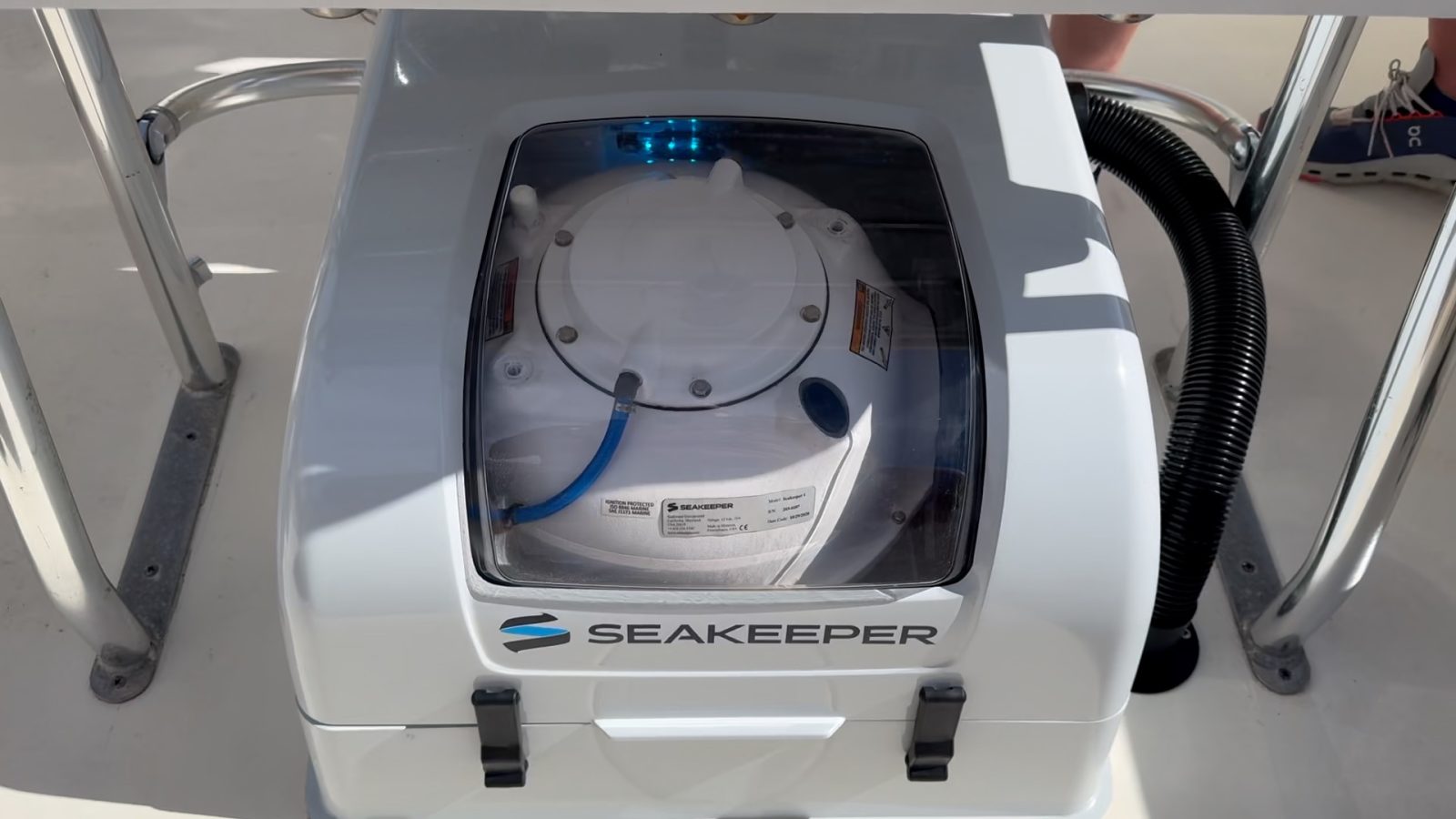
In the last year, Panbo(at) has had both Seakeeper Ride and now a Seakeeper 1 gyro installed. I know it may seem like it, but Panbo(at) didn’t have a stability problem before both products were installed. In fact, the boat’s ride impressed me even without any aids. But, now that it has these two systems keeping the boat’s movements in check, I can’t help but marvel at how much better the boat rides. Seakeeper’s systems have taken a boat with good manners and made it dramatically better. That’s quite the accomplishment.
The gyro
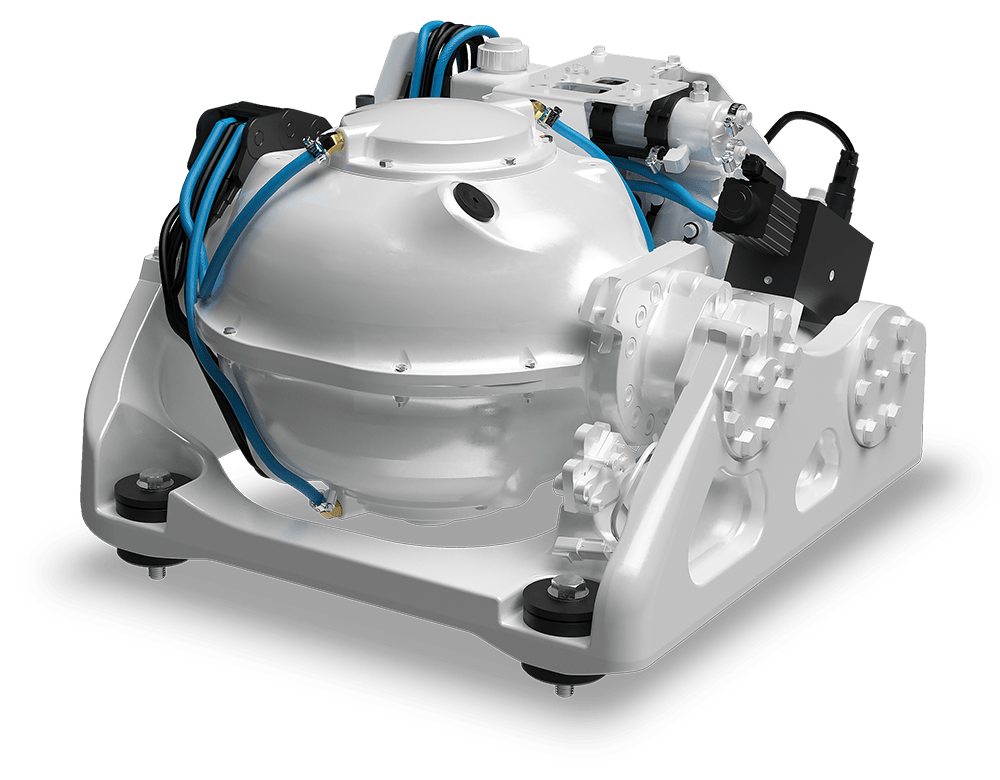
The Seakeeper 1 is Seakeeper’s smallest gyroscopic stabilizer. Like all of Seakeeper’s gyros, the model number corresponds to the angular momentum of the gyro at rated RPM. The 1 generates 1,000 newton meters per second of angular momentum. If you’re more familiar with foot-pounds, 1,000 newton meters per second is roughly 738 foot-pounds per second. Once fully spun up, the gyro delivers a maximum anti-rolling torque of 2,620 newton meters or just shy of 2,000 foot-pounds.
The 365 pound unit is just under 23 inches long, 24 inches wide, and 16 inches tall. The 12-volt DC powered unit is seawater cooled via a small DC pump feeding a heat exchanger in the unit. The gyro can be controlled via a dedicated Seakeeper touchscreen control panel or via most modern MFDs utilizing an Ethernet link and HTML 5 control application.
The $16,900 gyro consumes a maximum of 600 watts of 12-volt DC power during spool-up. Once at steady state the ratings show at least 225-watts of draw. So far, it draws a good bit less in nearly all circumstances. It takes 35 minutes to reach it’s maximum speed of 9,750 revolutions per minute but can begin stabilizing in just 18 minutes when it reaches 7,310 RPMs.
Seakeeper rates the 1 for 23 to 30 foot boats. So, my humble 22-footer shouldn’t present much of a challenge.
Installation
I was part of the NMMA Innovation Awards judging panel that awarded the Seakeeper 1 an innovation award. We were impressed by a few aspects of the 1, but we felt the biggest advance was the gyro’s ability to precess (roll) through its range on a deck mounting with no need for clear space and hence a penetration into the deck. Previous Seakeeper models, including the 9 I had on Have Another Day, require a clear area below the mounting point for the ball the swing. Installation without a hole below the unit opens a lot of above-deck mounting options.

Tri Sea Stabilizers installed my unit at their Tampa Florida location. As the side of their truck says, the only thing they do is install Seakeeper gyros and Seakeeper Ride. From the moment I pulled into their facility, it was clear this wasn’t their first rodeo. The installer who completed my project, Joe, jumped right on the boat and immediately confirmed that our plan would work. About the only complication was a lower step on my leaning post that would have pushed the gyro a little further back than I’d have liked. Fortunately, that wasn’t anything a sawzall couldn’t fix.

I think it’s very helpful and transparent of Tri Sea Stabilizers to publish the costs of the units and typical installation expense. This information highlights one issue for Seakeeper’s smaller gyros. Installation isn’t a whole lot less involved for the $16,900 Seakeeper 1 than it is for a $169,800 Seakeeper 18. So, Tri Seas says the average install of a 1 costs $13,360 or 79 percent of the price of the gyro. Tri Sea also says the average install of an 18 costs $28,500 or just 17 percent of the cost of the gyro. That aside, Tri Sea says the typical total cost of a 1 with installation will be about $30,000.
A stout structure
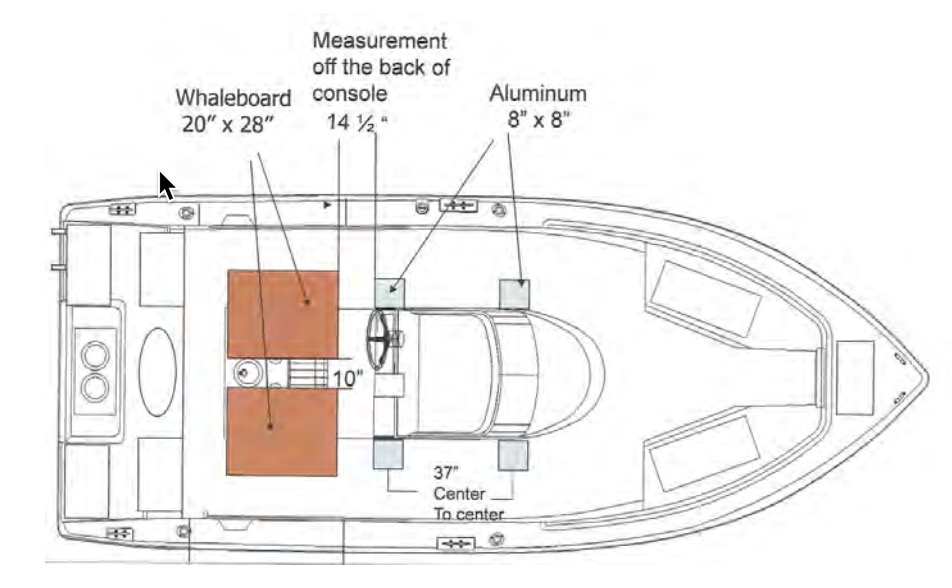
On Panbo(at) the flat deck compatibility allowed the gyro to be mounted under the leaning post aft of the helm. This nicely centered location puts the weight of the gyro in a good spot. Plus, I learned my Cobia 220cc’s already impressively tough laminate schedule gets even tougher under the leaning post. Cobia laminates in reinforcing whaleboards under the leaning post. Conveniently, these boards are directly under the gyro’s landing spot.

During my time in Tri Sea’s shop, I came to understand that although my installation was pretty straightforward, a little challenge won’t slow these guys down. It took about ten days start to finish for my installation. I was in and out of the shop during that time. While I was there, I got to see several stiffeners, mounts, and adapter plates made by their in house fabricator. Fortunately, in my case, Cobia’s stout structure and Seakeeper’s glue down design saved time and expense in the installation by not having to custom fabricate a mount.
Installation of the 1 consists of four main components: gluing down the plate on which the gyro sits, supplying power to the gyro, installing a raw water cooling loop including pump, and optionally connecting Ethernet for MFD or Seakeeper touchscreen control. With Panbo(at)‘s already crowded helm, we made the decision to use one of the existing MFDs.
Installation begins

The very first step of the installation was to clear the decks (literally) so there was access. Up next, Tri Sea laid down plastic to protect the deck. With that done, it was on to grinding the gel coat off the area where the gyro’s mounting plate would be glued down. Getting down to bare fiberglass ensures a good bond between the deck and plate.
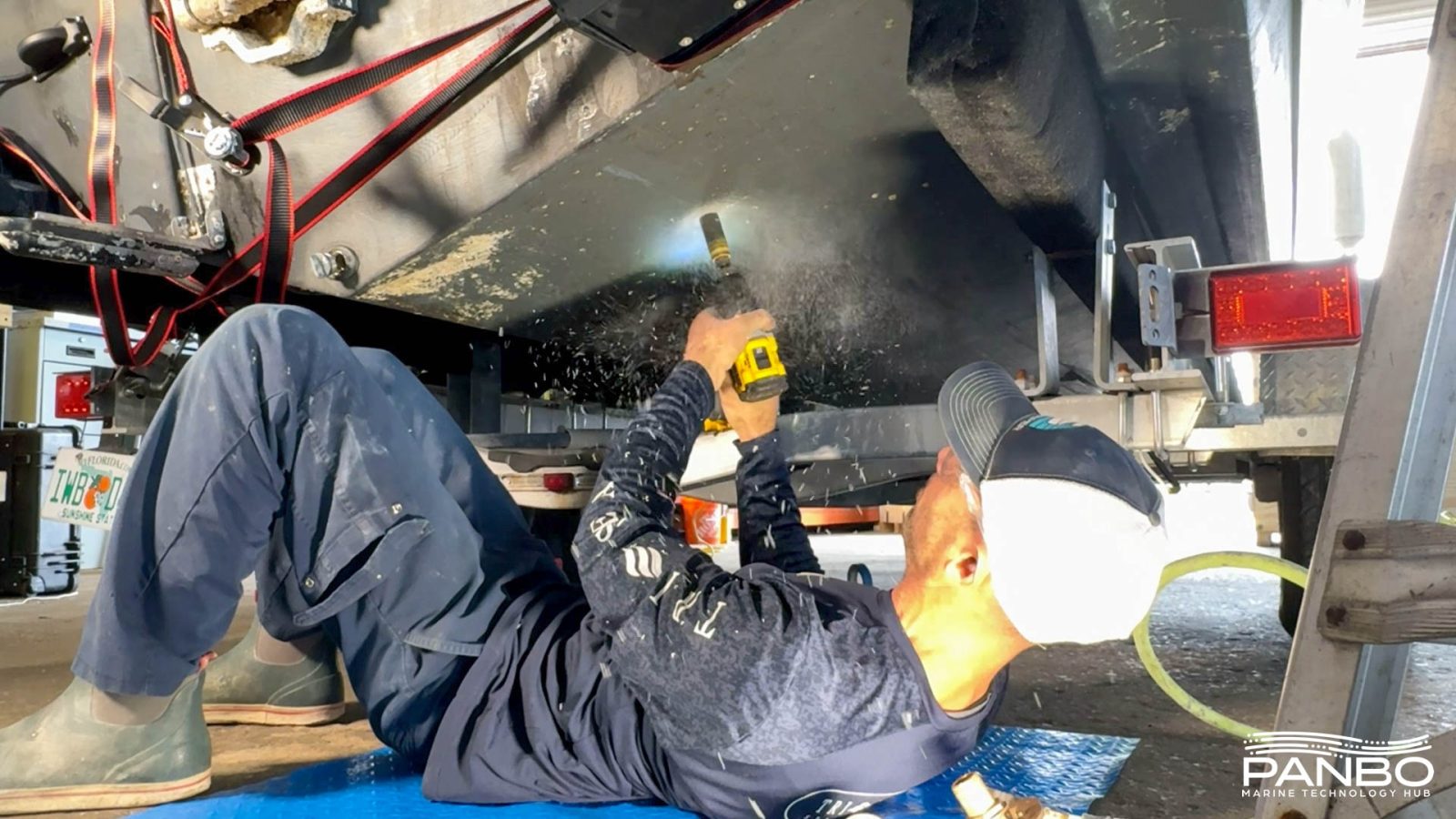
No boat project is complete without a new hole in the bottom of the boat. This hole is for the water pickup for the cooling system on the gyro. In contrast to the cooling system on the larger, AC powered gyros, the 1 only runs the pump when temperatures call for it.

Fortunately, rigging access between the aft compartment under the bench, pictured above, and the Seakeeper’s location is straightforward. Joe spent quality time under the bench preparing plumbing, power, and control runs.
Securing the unit
With the rigging run identified, holes drilled for water intake and discharge, and the raw water pickup in place. It was quickly time to glue down the mounting plate.
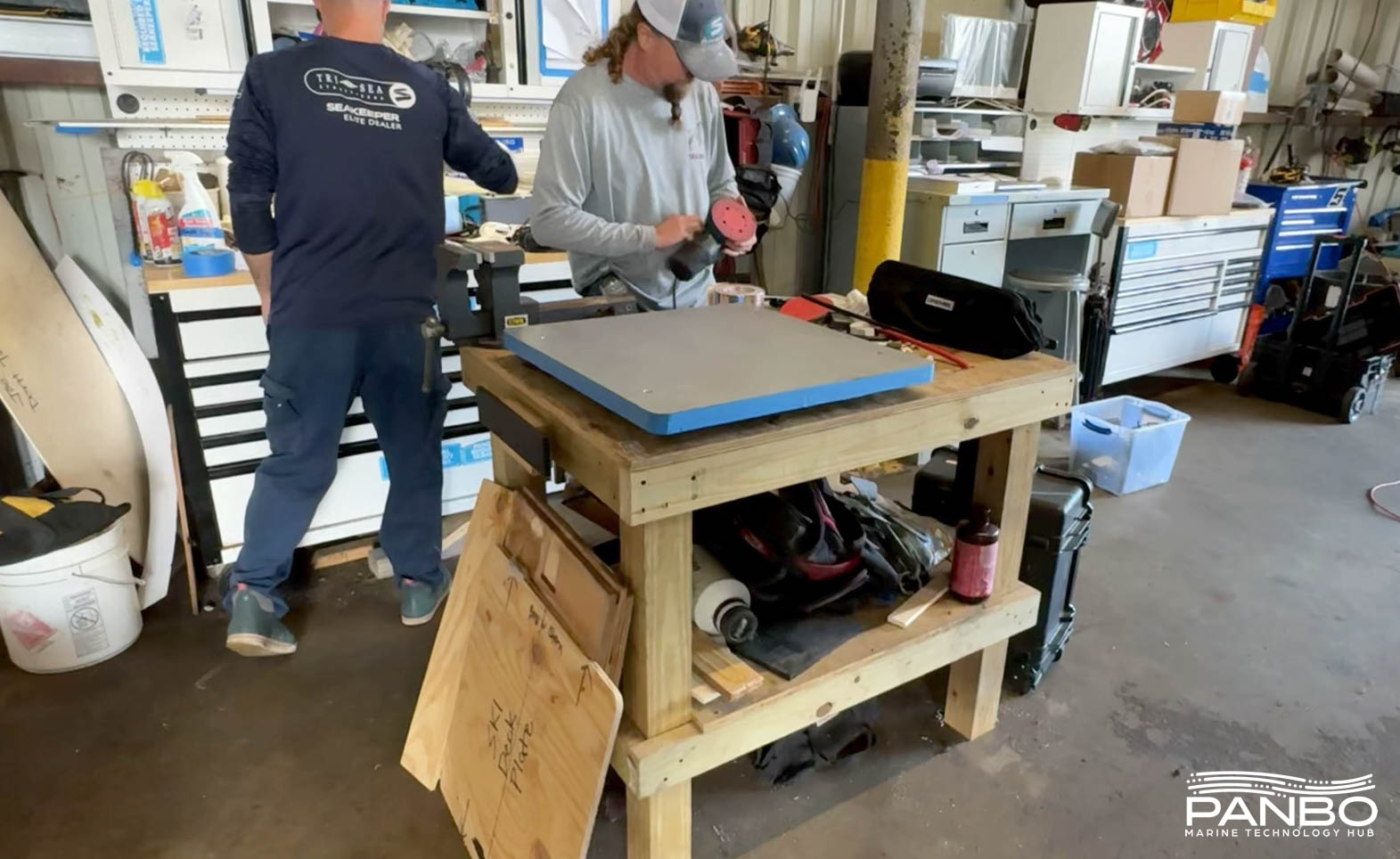
For deck mounted installations, Seakeeper has a beefy plate that is glued down onto the deck. In turn, the gyro is then bolted to the plate. The first step in the gluing process was to rough up the surface of the plate to maximize grip. This helps the adhesive better grab the surface of the plate.
The plate is held onto the deck with a structural adhesive. The adhesive is two parts and gets mixed shortly before it is applied to the deck. Tri Sea put four small screws on the deck under the adhesive. Those screws were all driven to the same height to serve as a spacer to hold the proper spacing while the adhesive was still wet. Once the adhesive cured, it holds the gap perfectly.
After the adhesive cured, the gyro itself was lowered into place on the plate. Four big bolts hold the gyro to the place. With those secure, the rest of the installation comes down to making the electrical and plumbing connections and adding the deck mounted cover.
Seakeeper 1 on the water
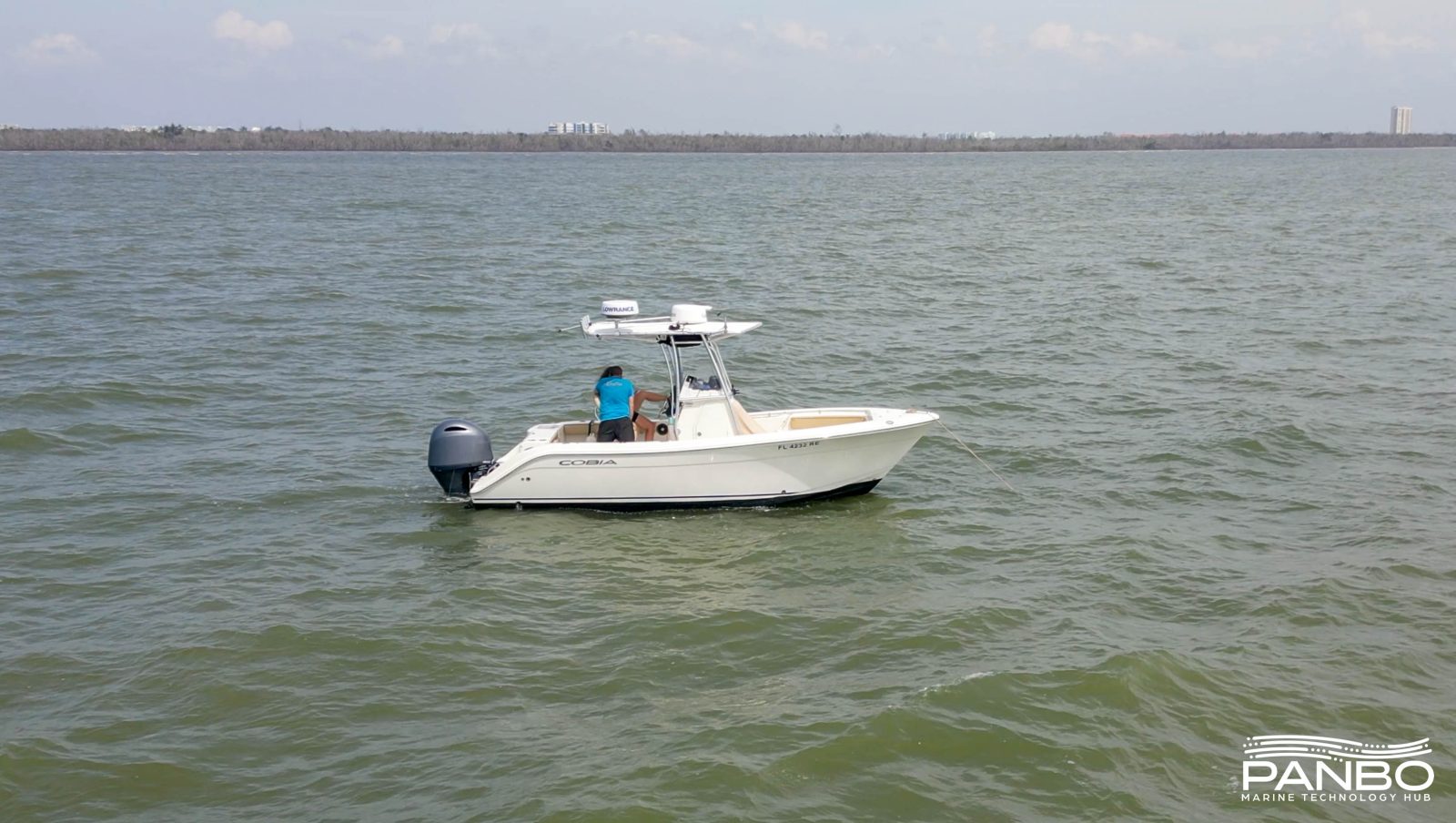
Perhaps part of Seakeeper’s success comes from the ease of demonstrating their gyro’s impact. If you’ve been to an in water boat show, there’s a good chance you’ve seen a demonstration rocking a Seakeeper equipped boat. A few adults get a smaller boat rocking nearly rub rail to rub rail. Then, someone releases the brake on the stabilizer. Within seconds, the boat simply stops rocking. Those who moments ago were effectively rocking the boat suddenly look silly as they flail about and the boat doesn’t move. I’ve done that same demonstration with quite a few people. If it’s the first time they’ve seen this demo, it tends to bring a smile to their face and incredulity that the system could really be that effective.
Gyroscopic stabilizers are most effective at rest and displacement speeds. As planing hulls go faster, they generate lifting forces to get the boat out of the water. My understanding is that the combination of the lifting forces and the control surfaces on a planing hull generate greater lateral stability. Hence, there’s a natural roll resistance once the hull is on plane. But, at idle and displacement speeds there’s little resistance to rolling.
The video above shows the boat at anchor on a fairly windy day with decent chop and ground swell to the water. At anchor, with the gyro locked or disabled, the boat is both rolling side-to-side and pitching fore-and-aft. When the gyro is unlocked and allowed to precess, it generates stabilizing force against rolling. Note that by installing the gyro in a side-to-side orientation, it has no impact on pitch.
Slow is pro
Similar to my experience on Have Another Day and its Seakeeper 9, Panbo(at) with the gyro running gains a new pleasant cruise speed. Since the Seakeeper was installed, I’ve found myself running the boat at 5 to 7 knots quite frequently, and often in open water. That’s just not a speed I ran prior to the gyro. I can’t say that I even realized I avoided slow speeds in open water but I sure notice the frequency with which I use that speed now.
My family and I often take visitors to our area out on the boat. One of the highlights of those excursions on the water is when the dolphins decide to put on a show. Frequently, viewing that show means a quick button hook manuever and then sitting still. That usually results in boat wake, our own included, rolling the boat to a degree than can be uncomfortable. With the gyro on, that’s not an issue.
I’m not much of an angler, so I can’t report on the impact the gyro has on fishing. But, I can certainly imagine that those who fish regularly would find the same benefits of a stable platform that I do.
Power management
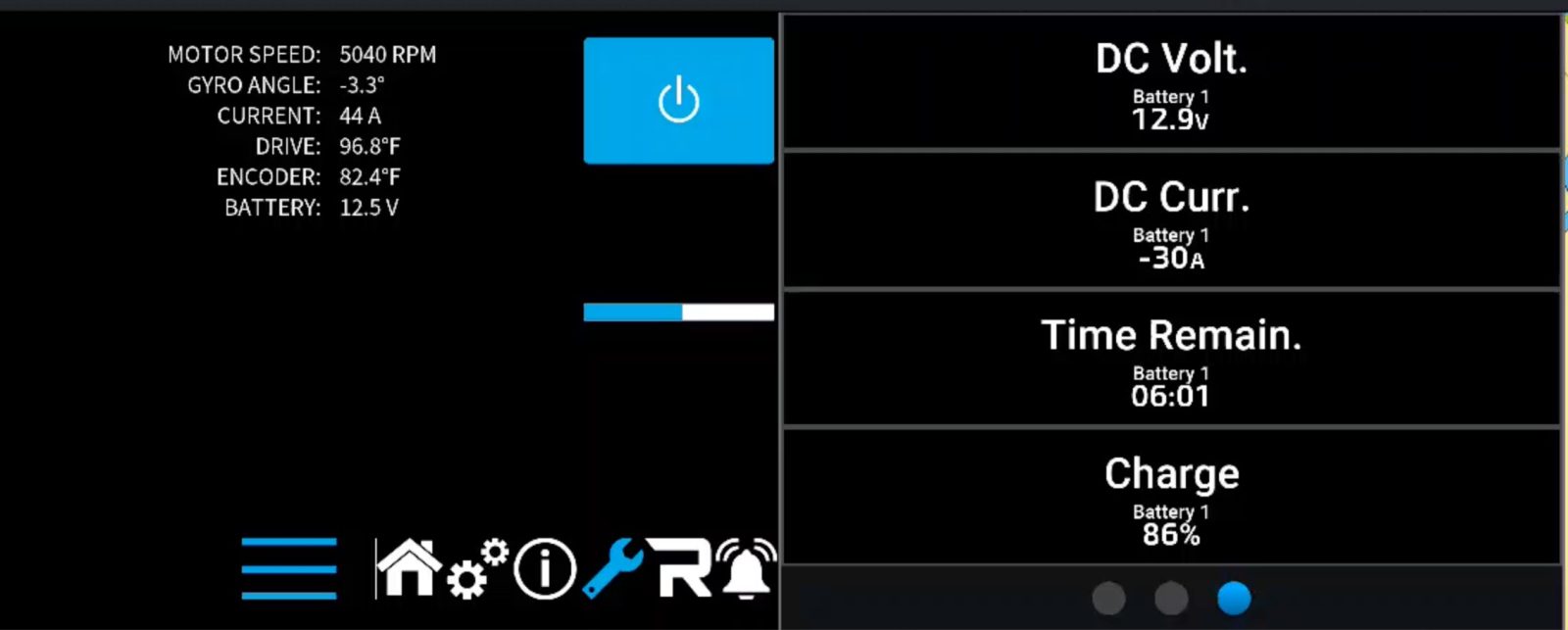
Panbo(at) is powered by a Yamaha 150 horsepower F150 engine. The F150’s alternator outputs a maximum of 36 amps while the Seakeeper draws up to 50 amps while spinning up. Even before the installation of the gyro, I ask a lot of the electrical system on Panbo(at). The boat has Dometic all electric steering, Seakeeper Ride, multiple chart plotters, a large stereo, and myriad other electrical components.
Fortunately, Panbo(at) also has a 215 amp hour dual purpose LiFePO4 battery from Lithium Pros. That 215 amp hour capacity helps immensely in riding through the startup load of the gyro. As you can see in the screenshot above, the gyro is consuming 44 amps of which 30 are coming from the battery.The Seakeeper 1 can be configured to spin at 9,750 RPMs for full stabilizing force or at a slightly reduced stabilizing force when spun to 7,040 RPMs. The 1 is rated for 23 to 30 foot boats. Since Panbo(at) comes in a little under that size, I usually run the gyro at its lower RPM setting and have been pleased with the performance. This lower RPM setting is also more power efficient since its not working as hard to spin the counterweight as fast.
Once the gyro is up to speed, steady state power consumption is around 10 amps. Sea state impacts power consumption. Each time the gyro precesses, it’s converting rotational velocity into a stabilizing force. That rotational velocity has to be replaced by the motor running a little harder to recover the RPMs. In practice, about the most I’ve seen the gyro consume once up to speed at 7,040 RPMs is about 15 amps. I’ve also noticed that when the unit is spun to its full 9,750 RPMs, power consumption increases to between 15 and 20 amps.
Just above idle, with all the boat’s systems powered up, there is about 14 amps of current available. If the gyro is running and spun up, that means 3-4 amps of charge current go to the battery. On plane, the engine consumes more power. Most of the time on plane the battery is either slightly discharging or charging.
Typical days on the water see the battery losing a few percent state-of-charge. I shut down the stabilizer when I’m on the protected channel leading to the boat’s storage facility. Typically, the battery takes a little extra charge. In the two months since I’ve had the gyro installed, I’ve plugged the boat into a charger twice. One time was when the battery switch was accidentally left on, the second was after a day on the water swimming. We anchored for several hours with the engine off and the gyro running. That consumed about 20 percent of the battery’s capacity.
Understanding that my boat is actually under the minimum size rating for this gyro, I’m quite pleased with how power has worked out. If the boat were just a little larger, it would likely have either a single, larger outboard or twins. Either of those would have an alternator capacities larger than mine and likely no problem at all keeping up with the load.
Seakeeper Ride and Gyro working together
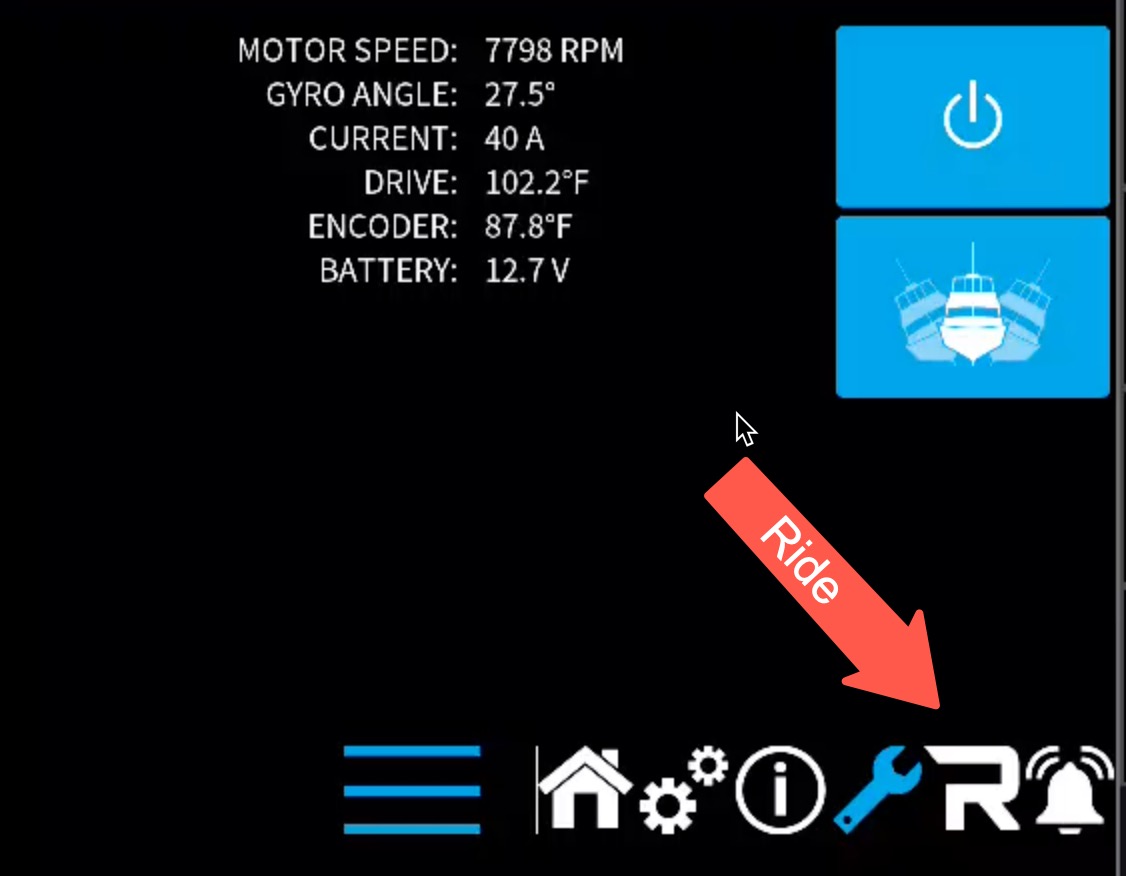
It may come as a surprise, but Seakeeper Ride and a Seakeeper gyro don’t coordinate with each other. The two systems both go about their work independently. But, that lack of coordination doesn’t mean they aren’t complementary. Quite the opposite in fact. As I mentioned previously, the gyro is most effective at rest and at slow speed. In contrast, Ride doesn’t begin to work until the boat is moving over 10 miles per hour.
In fact, nearly the only integration of the two systems occurs in the MFD app. When both systems are connected to the MFD, there’s a single Seakeeper app. The screenshot above shows the Seakeeper app controlling the gyro. But, if you press the R in the menu at the lower right, it switches the app to control Ride. But, I don’t believe there’s any communications between the two systems.
Effectively, the two systems are modulating and controlling different parts of the boat’s behavior. The gyro takes care of the big rolling motions, especially at low speed, that make many uncomfortable. Meanwhile, as soon as the speeds pick up, Ride adjusts the boats fore and aft trim as well as side to side list. Ride also uses the controllers to mitigate pounding in rough seas and rolling motions on plane.
There is something quite remarkable about a boat ride in which all aspects of the boat’s motions are optimized. This past weekend we took some boater friends out on a marginal weather day. We weren’t going far and we would be in very close proximity to land the entire time. But, we did have some stout wind coming out of the south west with minimal land protection. We ran the boat at low speed for quite a while and then up on plane. At low speed, your eyes instantly tell you the story of what the gyro is doing. But, at high speed, Ride’s impact is a little more subtle. Subtle that is until you turn it off. Once I put Ride in manual mode, the waves the boat was skipping over became the waves the boat crashed into and over. The difference though profound was harder to appreciate.
Final thoughts
I have now had a Seakeeper gyroscopic stabilizer installed on two boats I own. In both cases, the gyro dramatically changed the behavior of the boat and made using the boat more pleasant. Both gyros also increased my use of the boats at low speed. For me, that’s often where I’m happiest, enjoying a day on the water. There is no question that this is a luxury product. But, when I look at the average cost of a new boat in this size range, $30,000 doesn’t seem unreasonable at all. In my life, I’ve spent a lot of money on boats and boating. Products that make boating more comfortable and enjoyable will always gather a large share of my wallet.













Ben
I am a Seakeeper believer! It is a game changer. I have a 65ft SeaRay with the gyros. There are two stories that illustrate when I really noticed how well it works. The first was when I had to take the boat from Marina Del Rey to Channel Islands Harbor. My wife, a fair-weather boater could not believe that when we arrived, I actually took her through Small Craft Advisory conditions. The Gyros kept the boat from rocking side to side which is when she gets concerned.
The second time was shortly after that. A group of other boaters were with us on Santa Cruz Island. They were all at anchor and came to our boat to have lunch. We all marveled at looking how all the boats at anchor were being rocked so much by the swells that day…Except ours! Flat as a rock at anchor!
When I explain to people that it doesn’t stop a boat from lifting with the sea, as that is pure physics, what it does is stop the rocking once a swell or wave passes, thus the boat remains very smooth.
Believe me, a Seakeeper is now mandatory for new boats in our family.
Love the super in depth review of this. I am considering using a seakeeper for when I take my 1967 Cal 48 sailboat to the South Pacific where anchorages are often quite rolly. I have not heard about sailboats using a seakeeper yet but it seems like a great idea to make moorings and anchoring a lot more comfortable. Do you have thoughts on this? I already have 1,500amp hours of lithium aboard so I’m not worried about the power usage. I am a bit worried about the noise though. Is it loud for those aboard?Would other boats nearby hear it?
Mike,
First the easy question: noise. As measured by a sound meter, the gyro is almost inaudible. It does introduce a slight hum into the boat. When I turn off the engine, stop the stereo, and listen, I can definitely hear it. I wouldn’t call it unpleasant or obtrusive, but it’s there. There’s absolutely no chance anyone in an anchorage would hear it. If you’re on one end of a 48 foot boat and it’s on the other, you won’t hear it. On my Carver, the Seakeeper was the other side of an engine room bulkhead from my stateroom. With the generator off and everything else shut down, I could hear it as it spun down, but only when the boat was totally shut down.
I have never inquired of Seakeeper about performance on a sailboat. I don’t see any reason it wouldn’t work, though some of the details could be different between desired healing and the impact of a heavy keel on roll motions. I’d love to hear more if you do get in touch with them about the viability.
-Ben S.
Great to know that there’s not really a noise issue. The idea would be to use the stabilizer at anchor only, not while underway. Nevertheless I could imagine that the keel could impact the performance of a gyro stabilizer so it may not be a feasible idea. I’ll let you know what I find out about this.
Where would it be installed in the sailboat?
Most likely in a dinghy.
Sailboats keel does not play nice with a gyro.